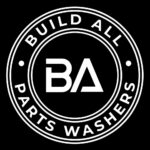Heated aqueous parts washers come in incredibly handy for those working in machinery and automotive maintenance, as they enable workers to remove stubborn dirt, grime, and grease from their parts and components. Most parts washing detergents are activated at certain temperature and this increases their effectiveness. Typically, most parts cleaning detergents require a minimum temperature of 105 degrees (F) to activate. These washers not only make the cleaning job easier, but they can also save time and money, as they represent an efficient cleaning process. With latest advances in heated aqueous parts washers technology, Build-All can provide you the correct combination of parts washer, heater, and chemistry
Conclusion
1. Heated aqueous parts washers can help remove stubborn dirt, grime, and grease from parts and components
2. The heat also helps to evaporate the water more quickly, so your parts are dry sooner
3. In addition, detergents require heat in order to maximize cleaning effectiveness. Heating the water can increase the cleaning power of the detergent you’re using.
4. It’s important to not run a heated parts washer “dry” as it can easily burn out your heater.

